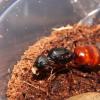I was told this was aphaenogaster uinta but I wanna be sure on it. There aren’t many records in Cali so it would be cool to keep these. I am sure they are aphaenogaster to. Me and my friend had collected them from under a rock.
1. Found in stirling city California
2.time found unknown.
3.Found in mountains at 3000 elevation in a pine forest with Camponotus modoc everywhere.
4.around 4mm for workers and queen 8mm
5. Color of the spe are orange red and black
6.unknown
7. Unknown
8.they were nesting under a rock
9. They were collect but recently we found a founding queen under a rock and think they fly around early may.
10. Pic below
Edited by KadinB, July 6 2021 - 11:08 AM.


























